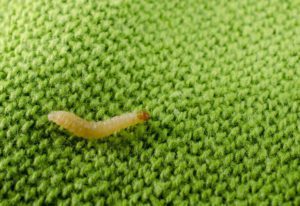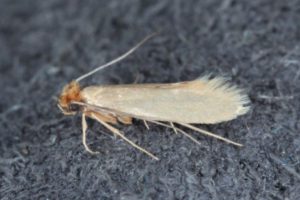CLOTHES MOTHS IN YOUR HOLIDAY SWEATERS?
By Zachary Ciras on December 18, 2020.

Clothes moth larvae on green holiday sweater. Shutterstock.
Holiday parties are not happening this year for the obvious reasons, so you may have yet to unpack that gaudy Christmas sweater. And since we’re mostly spending our time in our climate-controlled homes, sweaters, blankets, and other stored winter woolens may be just starting to make their appearance. Nothing like pulling your favorite ugly sweater out of storage only to find it now has several new ugly holes.
Who done it? Depending on where and how your woolens were stored, there could be more than one suspect. Pests that will gnaw on fabrics, especially woolens, include carpet beetles and other related beetles, silverfish, crickets, cockroaches, even mice, but clothes moths are probably the most likely cause of damage to stored woolens.
WHAT DO YOU DO NOW?
First off, you’re probably going to have to replace that sweater. Then, you’ll have to inspect all other woolens stored nearby for insects or damage to determine the extent of the infestation.
If you can confirm that clothes moths are the culprits by finding live or dead silvery beige moths, caterpillar moth larvae, shed larval skins, or their silk cocoons or webbing in the storage area, you now know the enemy. Avoid mixing the sweater in with other clothing in case there are eggs or larvae still present.
If an article of clothing or a blanket appears to be infested but is salvageable, or might be infested by association, dry cleaning the item will usually kill all stages of any insect pest.
EXTEND YOUR INSPECTION TO OTHER AREAS AND OTHER ITEMS
Unfortunately, clothes moth and carpet beetle larvae don’t limit themselves to wool sweaters, they can move out to infest other wool items in a home. Wool rugs are a favorite food, but furs, horsehair insulation, even trophy mounts are examples of other potential infestation sites (see Clothes Moths Aren’t Found Only in Clothes).
The actual damage risk to other woolen or animal-based materials will depend on where the moth infestation was found (box in the attic vs. a cedar chest in the family room), how long it’s been going on (did you wear the sweater last winter or has it been years?), and how many moths are involved (saw just one in a box vs. 20 in a closet).
LEARN HOW TO STORE YOUR WOOLENS PROPERLY
This is the most important tip we can give you when packing up winter items: Make sure woolens are newly dry-cleaned. Sweaters, coats, blankets, etc. that are just boxed up again on a warm day come spring without considering whether they might be soiled are at the greatest risk of attack from fabric pests. Various food stains and spills are an issue, but perspiration and urine stains are also a no-no. Want to find out why? Read Why Do Fabric Pests Prefer to Dine on Dirty Clothes?
Should you then box up winter woolens at the end of the season or is it better to hang them up, maybe in a garment bag? For details on what to do and how to do it, see Finding Insect Damage to Your Sweaters and Woolens?
Beyond packing up clean clothing, make sure you pack items in as air-tight (and bug-tight) a container as possible. Cardboard boxes are not a good choice, even if you’re going to throw in mothballs (see below). A tied-off or zip-sealed plastic bag can work, as can a plastic tub with tight-fitting lid.
SHOULD YOU USE MOTHBALLS NEXT TIME?

Clothes moth on fabric. Shutterstock.
Mothballs, moth crystals, and cedar are not the clothes moth preventatives we believe them to be (see Do Mothballs Repel Clothes Moths, or Not?). The first two are pesticides, believe it or not, and must be used according to federal labeling guidelines. This rarely happens.
Mothballs and moth crystals are fumigants which kill or repel by filling the air space with vapors. This can’t happen unless the container is airtight (not even a taped cardboard box qualifies). People don’t use enough of the product to be effective, either. A few mothballs tossed in is a waste of money. Experts say that storing cleaned clothes properly is usually enough alone to protect most items in most situations.
Depending on what seems to be infested and where, control of clothes moths can range from dry cleaning a couple of items to insecticide treatment of large, valuable items such as oriental rugs or hunters’ trophy mounts. A storage area (attic, walk-in closet, dresser) may need to be treated with insecticide to kill wandering moths.
Our experts at Colonial Pest Control can help determine the severity of the fabric pest problem and what controls are needed. When we interact with customers or enter a home, we implement all necessary COVID-19 PPE and precautions to make sure that you are safe and comfortable with our service. Give Colonial Pest a call!